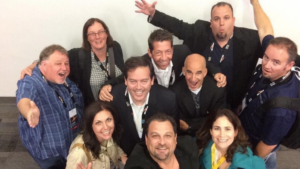Humans are social creatures; this is something we all know and understand. But recently, at the Pivot conference in New York, I had the pleasure of interviewing Scott Hebner (VP of Social Business at IBM) and friend Kare Anderson (author, speaker, columnist and coach) on a main stage appearance about how human behavior fits into the context of social marketing. Given that humans consume socially, where is social marketing headed as it matures?
What emerged was exciting. According to Scott, the future of social marketing involves “human sensory building”, and weaving this into the marketing experience at each stage of the customer lifecycle. I agree and also believe that directly relatable experiences that human senses bring to social situations will change how we consume information.
Here are five sensory experiences that are building the social future:

Listen – For everyone, if you don’t truly listen to what’s being said, you can’t hear what’s truly being said. Have you ever watched your television with no sound? Then turned on one sound output? Then surround sound on top of that? I believe the amplification of sound across the Internet is only going to get better. The technology put in our hands to record audio has evolved from a complex microphone and soundboard to an iPhone, allowing anyone to develop incredible quality. Will it replace radio? No. But it will enhance it. The audible experience combined with social engagement will continue to create an experience radio has never seen before, giving brands the ability to interact with their customers in more robust ways.
Play – Our world is a multifaceted, gamified learning experience. Our kids are learning on touch screen computers that help them educate themselves in a fun way by rewarding them with earned points and levels. Our teams at work are being given digital achievements and benchmarks that encourage them in a clear and concise way to keep achieving. It’s no wonder social measurement companies like Klout and Kred showed up on the scene; as humans, we will always need goals to pursue and thrive on recognition and reward. Gamification turns the social web into play and makes even the simplest of tasks – say, checking in on Foursquare – a fun, achievement-filled quantifiable activity.
Talk – Engagement is the bond that brings us all together. It’s with a common mutuality (as my friend Kare puts it) that we find common ground to live and work together and connect. The social web has magnified these experiences, which I believe has pushed people beyond their comfort zone. From a letter, to the phone, to email, mass communication has evolved. Take these mass communication changes and integrate them publicly, for the world to listen in to your conversations and read your stories; this is social media. Some express, and some try to impress. This massive communication network magnifies our standard offline interactions. Because it’s become more accessible, it’s forcing everyone to be more transparent. Talking out loud to the world is high risk, high reward. The people and brands that learn how to talk on the social web will thrive.
Learn – Learning has evolved from the singular interpretation of fewer stories, to the many versions of stories and thoughts. Everyone is quickly becoming a content producer. The real challenge here is knowing what content to trust. It’s free and available on the social web. I triple dog dare you to not find content related to something you want to learn. If the unlimited sources to learn have become a commodity, then the opportunity for brands to become educators and publishers is becoming the true value. The future of learning will rely on trusted “social curators of knowledge” who help to pull together only the most valuable information.
Influence – You might say that helping others comes naturally to the human race, but for most people, it doesn’t. Yet on the social web, it’s the single most effective form of earning trust and gaining influence. While I strongly believe that everyone is an influencer on something, the challenge becomes finding who is the right person for what you’re interested in. In social marketing, I’ve heard the “Age” we’re living in coined several different things; the Age of Context. The Age of the Customer. The Age of Commerce. It goes on and on. For me, it is the Age of Influence. In every conversation, online and offline, word of mouth has never traveled so quickly, influencing people to move to decisions and action based on trust earned on the social web.
Touch – At the end of the day, we are all consumers of things. Whether you’re shopping in store or researching online, we all are looking for value to enhance our lives. Touch is the most tactile sense, because it confirms a good or bad decision when we’re deciding to invest in something. As consumers, although our survival requires us to purchase food, clothing and shelter in order to live every day, we find ourselves looking for things that make our lives easier or make them more fun. Where, when and why to touch is an intuitive experience. Apple has made a fortune investing in understanding how humans touch a screen and interact with 2-dimensional applications that improve our lives. The future for brands, to succeed in creating a branded sensory experience people will want to talk about is rooted in its hands-on user experience.
TAKEAWAY: The social web is only as good as how well it connects to our social human sensory system. The more you can map these senses into your social marketing storyline, the deeper and more meaningful your reach will be.





